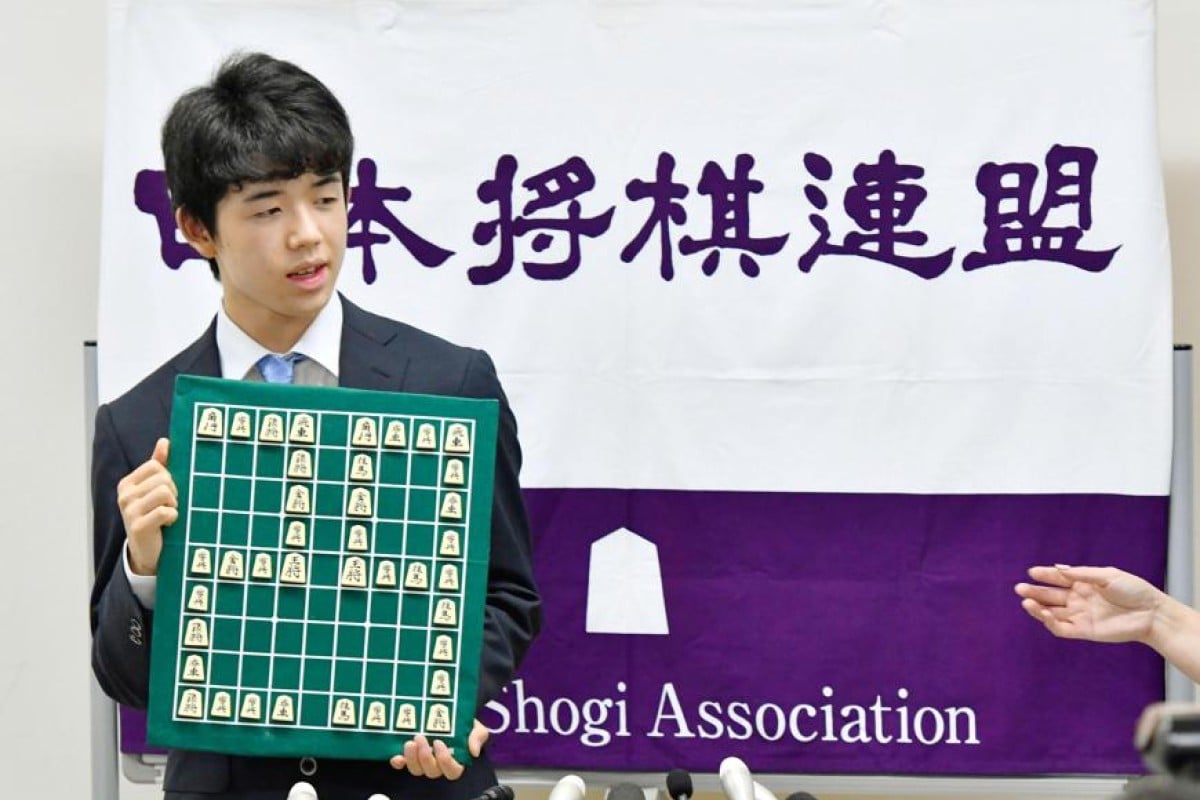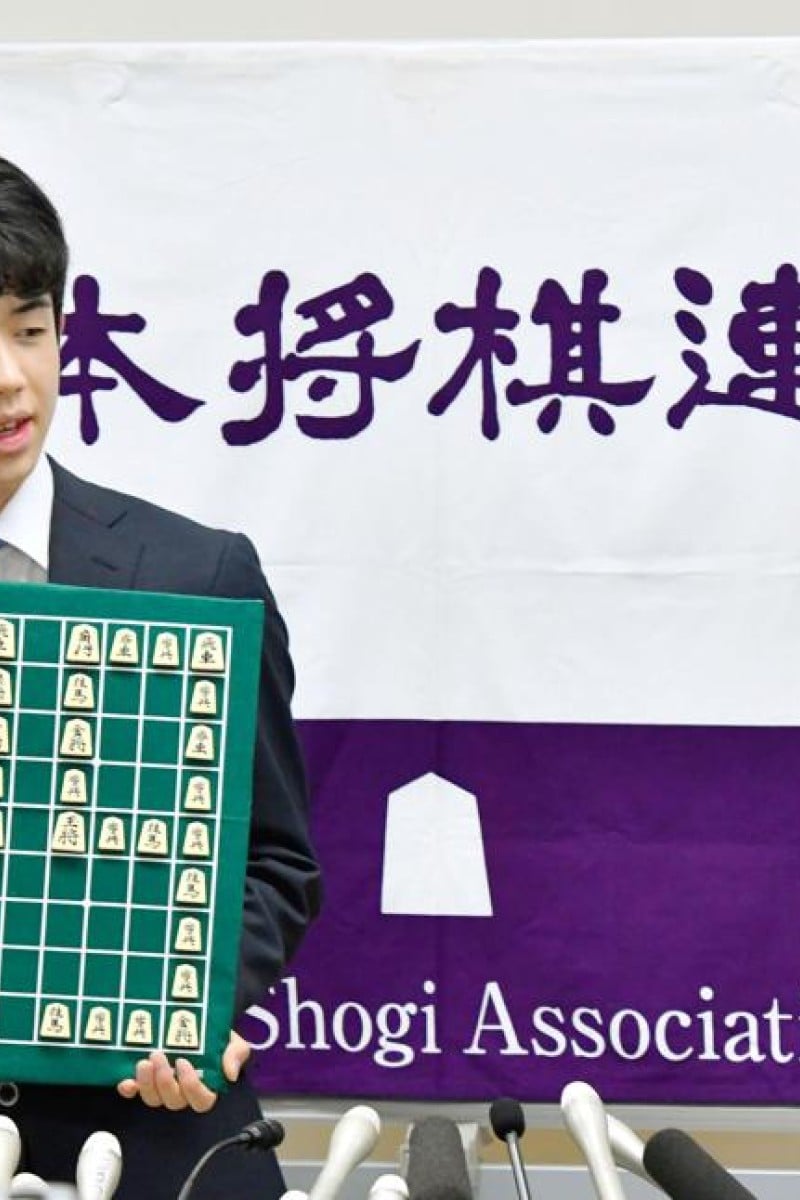 Sota Fujii holds a shogi board displaying his record in game pieces.
Sota Fujii holds a shogi board displaying his record in game pieces.Fourteen-year-old Sota Fujii, the youngest-ever professional shogi player who has just set the longest winning streak of 29 matches, is not only known for his outstanding talent but his fiery competitive spirit that often triggered tearful outbursts when he lost as a child.
“He is the personification of fighting spirit. He grew up by taking the frustration of a defeat and directing it to the next match,” said Masataka Sugimoto, Sota’s 48-year-old mentor who ranks seventh dan, or the third-highest rank in the professional world of the chess-like traditional board game.
One of the stories most often told about Sota, currently a fourth-dan secondary school student, is about an instructional match he held against ninth-dan player Koji Tanigawa, 55, who, when he was 21 years old, became the youngest player to capture the top title of meijin or master. As in the course of the match it became clear that Sota, a second-grade elementary school student at the time, was almost certain to lose, Tanigawa offered to call a draw. That prompted Sota to erupt in tears and hunch over the game board, drawing a crowd around them. His mother Yuko had to drag him away.
Born on July 19, 2002, in Seto, Aichi Prefecture, in central Japan, to a company worker and his stay-at-home wife, Sota began learning shogi at age 5, when he was given an introductory shogi game set from his grandmother. As he quickly surpassed his late grandfather in shogi, he started taking lessons at a shogi school in the neighbourhood where he was instructed by Rikio Fumimoto, the school operator, from age five to 10.
In a matter of a year, Fujii mastered a 480-page shogi textbook given to him when he joined the school although he was too young to read, said Fumimoto, adding that his intuition told him that the kindergarten pupil “would one day become a professional shogi player”.
In his first year of primary school, Sota would test his strategies against much older junior high or high school students. With his vocabulary sounding like an adult, Sota would take moves that were risky, yet offered a higher chance of winning, according to Sugimoto.
“He has got marvellous viewpoints and I was amazed that a seven-year-old kid would have such an insight,” he said.
Sota’s mother does not hide her surprise at her son’s intense focus. “He gets really absorbed in things he loves even to the extent that he cannot pay attention to other things,” said Yuko, adding that she tries not to disturb him whenever he is focused on something.
As a child, Sota also loved playing with the railroad toy Plarail, and drawing mazes. In primary school, he craved such books as Ryotaro Shiba’s Ryoma ga Yuku (“Ryoma Goes”), which dealt with Sakamoto Ryoma, a prominent figure in 19th-century Japan, and Shinya Tokkyu (“Midnight Express”), a travel novel by Kotaro Sawaki.
In 2012, just five years after he began to play shogi, Sota was accepted into “shorei-kai”, a highly selective society run by the Japan Shogi Association to train young and talented players. It is so competitive that only four members can be elevated to fourth dan every year and become professional players.
Sota joined the society with the lowest sixth kyu but worked his way up rapidly to attain the fourth dan in October 2016 at age 14 years and two months, rewriting the previous record held by ninth-dan Hifumi Kato, 77, who went pro in 1954 at age 14 years and seven months.
In his debut match as a pro in December, Sota defeated Kato, one of the most famous shogi players in Japan, known as “Hifumin” by his fans.
Sota’s winning streak has sparked interest in the world of professional shogi, including the prize money players earn. Top players could earn a fortune equivalent to hundreds of thousands of dollars per year with prize money and fees for competing in matches. Players may generate additional income by appearing on TV, making speeches and teaching students in classes.
In 2016, top earning Yoshiharu Habu, 46, who holds three championship titles, received more than 91.5 million yen (HK$6.36 million, US$816,000). Sota, who defeated Habu in an unofficial match in April, has already earned about 900,000 yen in prize money for winning a preliminary tournament of the Ryuo championship, one of the eight title matches professional players can take part in.
Monday’s match against 19-year-old fourth-dan Yasuhiro Masuda as part of the Ryuo championship finals brings Fujii an additional 460,000 yen, and if he wins the championship by beating title holder Akira Watanabe, he would get 43.2 million yen.
Shogi, a 20-piece board game popular in Japan, is similar to chess as two players alternate in moving one piece at a time to checkmate the opponent’s king. But unlike chess, players can reuse pieces once taken from their opponents and put them back into the game as their own pieces.
The historic record set by the shogi prodigy has further elevated the profile of the board game. Sota’s popularity has prompted many children to attend shogi classes and drawn strong demand for books on shogi, brain games he used to develop his sense of concentration.
Shogi has also been gaining traction, due in part to the popularity of Sangatsu no Raion (“March comes in like a lion”), a Japanese manga dating back to 2007. It was later adapted into animation, and a two-part movie shown this year. The work depicts the story of a 17-year-old secondary school student professional shogi player, and how he grows in his career and life.
Now all attention is on how far Sota will go.
“Although often touted as having perfect shogi technique, I believe Fujii will be even stronger,” said Sugimoto, Fujii’s mentor. “If all goes well, he might even become somebody beyond other players’ reach in several years.”
